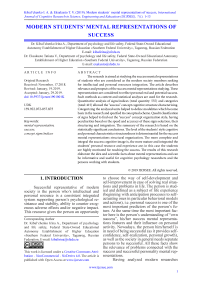Modern students’ mental representations of success
Автор: Kibal’chenko Irina A., Eksakusto Tatiana V.
Журнал: International Journal of Cognitive Research in Science, Engineering and Education @ijcrsee
Рубрика: Original research
Статья в выпуске: 1 vol.7, 2019 года.
Бесплатный доступ
The research is aimed at studying the success mental representations of students who are considered as the modern society members seeking for intellectual and personal resources integration. The article describes relevance and prospects of the success mental representations studying. These representations are considered to reflect personal real and potential success. Such methods as content and statistical analyses are used for the research. Quantitative analysis of signs/indices (total quantity: 555) and categories (total: 415) allowed the “success” concept cognitive structure characterizing. Categorizing the analyzed units helped to define modalities which become basic in the research and specified its conceptual scheme. Quadri classification of signs helped to find out the “success” concept organization style, having peculiarities based on the speed and accuracy of these signs selection, their structuring and integration. The summary of the research is based on the statistically significant conclusions. The level of the students' style cognitive and personal characteristics structuredness is determinantial for the success mental representations structural organization. The more complete and integral the success cognitive image is, the more mature and integrated the students' personal resource and experience are; in this case the students are highly motivated for reaching the success. The results of this research elaborate the idea and scientific facts about mental representations and can be informative and useful for cognitive psychology researchers and the persons working with students.
Mental representation, success, concept signs/indices
Короткий адрес: https://sciup.org/170198537
IDR: 170198537 | УДК: 159.922.072-057.875 | DOI: 10.5937/ijcrsee1901001K


